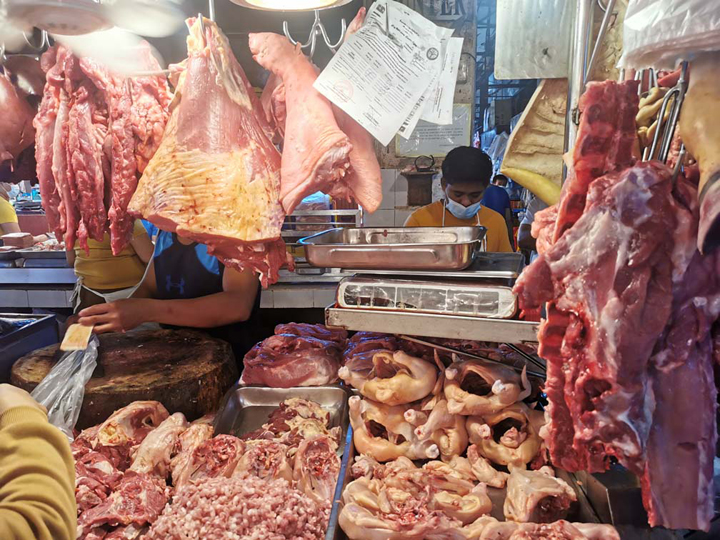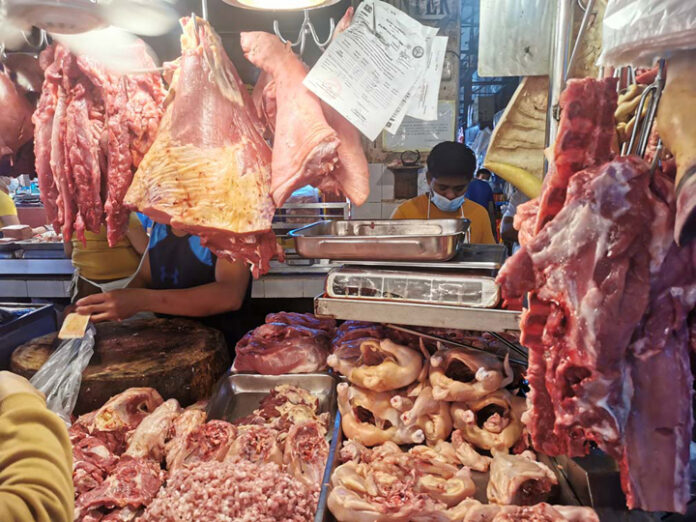
THE government has raised its proposed volume of imported pork to 400,000 metric tons (MT) this year to address the expected local demand for the food item.
This is almost double the initial proposal of the Department of Agriculture (DA) to raise the Minimum Access Volume (MAV) for pork to 164,000 MT.
The current MAV is only at 54,000 MT.
“The MAV Advisory Council endorsed 388,790 [MT] yesterday [February 8] to address the deficit [in pork supply]. This is what we call MAV Plus,” Agriculture Secretary William Dar said in an online press briefing on Tuesday.
Based on the country’s current hog stock, he explained local farmers could only supply between 1.2 million MT and 1.3 million MT of pork, while demand for the said food item is at 1.6 million MT.
Pending decision
Aside from the higher in-quota for imported pork, Dar said some members of the MAV Advisory Council are also considering allowing not only traders but also hog raisers to import pork if the MAV Plus will be implemented.
Dar said the recommendations will be subjected to a referendum by the MAV Management Committee before it is submitted to President Duterte, who will issue the necessary document for implementation of the said measures.
The proposal must then be ratified by Congress before it could be enforced.
Dar earlier said Duterte already approved in principle their proposal to increase the MAV.
Fully compliant
The government is considering temporarily raising the MAV to bring down the high prices of pork in the country, particularly in the National Capital Region (NCR), as a result of dwindling stocks from local hog farms that were hit hard by the African Swine Fever (ASF).
The DA recently implemented measures to bring more live hogs to NCR from areas in the country which are now affected by the ASF, to meet the region’s high demand for pork.
A 60-day price ceiling for pork products being sold in markets in NCR also took effect on Monday through Executive Order (EO) 124 to ensure it will remain affordable to most consumers.
EO 124 imposed a price ceiling for kasim/pigue at P270 per kilo and liempo at P300 per kilo.
Based on their inspection conducted by the DA and the Department of Trade and Industry (DTI), vendors and retailers are generally compliant with the price ceiling.
Trade Secretary Ramon Lopez said they are coordinating with the DA to also come out with a price cap for imported pork.
“We expect to bring down the price [of imported pork] to that of the price ceiling [under EO 124],” Lopez said.
Standardized measures
Amid hog supply shortage, chairman Benjamin “Benhur” Abalos Jr. of the Metropolitan Manila Development Authority vowed implementation of standardized measures on all local government units in Metro Manila to ensure that price ceilings will be implemented across all markets in the metropolis.
“What is important is the coordination and concerted efforts of the national government and the local government units in Metro Manila to make sure that the price of pork and chicken is within the implemented price cap,” Abalos said as he joined Secretaries Dar and Lopez in the conduct of price monitoring at Mega Q Mart and Commonwealth Market in Quezon City and SM Hypermarket in Mandaluyong on Tuesday.
The MMDA chief is eyeing to persuade the 17 local chief executives of NCR to waive daily rental fees among market retailers in the metropolis who don’t sell meat products for the day because of the shortage—a proposal from Quezon City Mayor Joy Belmonte.
“What is important is the coordination and concerted efforts of the national government and the local government units in Metro Manila to make sure that the price of pork and chicken is within the implemented price cap,” Abalos said.
Abalos said that they are coordinating with the national government and monitoring daily feedback from traders, market masters and local government units to normalize the supply and retail prices “the soonest time possible.”
“We will sit down with the metro mayors to discuss measures on assisting hog retailers to cushion the impact of supply shortage,” Abalos said.
He also lauded the DA and DTI for their efforts to provide loan assistance to market vendors.
Lopez said that the DTI also plans to set a separate price cap on imported pork products and this will likely be lower than the current ceiling of fresh meat.
During Tuesday’s market visit, there was a scarcity of supply in fresh pork products in Mega Q Mart, while prices imposed in Commonwealth Market were within the price cap.
Meanwhile, the supermarket in Mandaluyong is selling pork below the price cap.
A matter of livelihood
Meanwhile, the government was urged to present and implement a game plan to resolve the pork shortage and subsequent high prices in a comprehensive and holistic manner.
Senator Francis Pangilinan said Tuesday, the second day of the 60-day price ceiling on pork products, “We Filipinos love galunggong. The call to look for other protein sources is good. But the point is, pork supply in the markets is scarce. And this hasn’t been resolved. Why is pork scarce? Because of ASF and the typhoons. The ASF began in 2019; it should have been resolved. Millions of pigs have been culled; billions in income lost.”
The ASF kills not just pigs—it wipes out “hog raisers, market vendors, suppliers of feeds, truck drivers who deliver the hogs,” said the former secretary on food security.
The hog-raising industry, according to a 2018 DA paper, is worth at least P190 billion a year. And next to rice, it is the second-largest contributor to the country’s agriculture.
Stop-gap measures like a price ceiling and calls to eat galunggong are not enough, Pangilinan said.
On Monday, hog raisers and market vendors refused to sell altogether because the price ceiling is too low for them to even break even.

